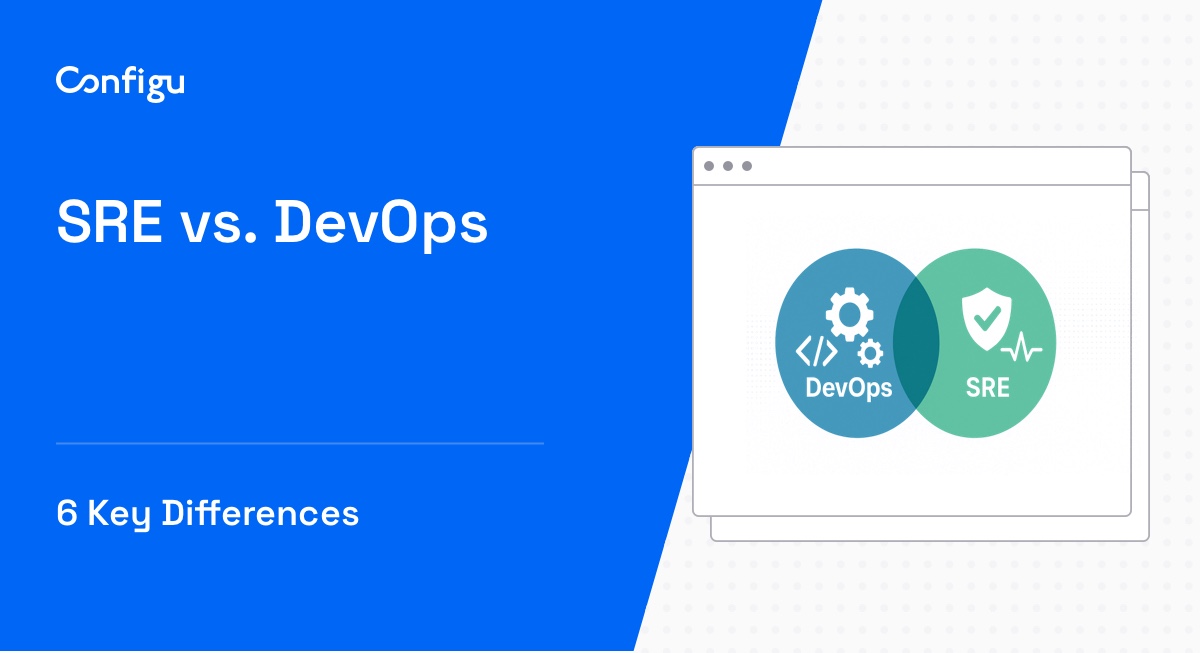The idea behind Configuration-as-Code (CaC) is that configuration data, traditionally managed manually or through proprietary tools, should instead be managed using code. In other words, it’s about treating configuration data just like we treat application code.
The adoption of CaC offers numerous benefits, including consistency, repeatability, and faster recovery from failures. It reduces the possibility of human error in configuration management, leading to higher reliability. Moreover, since configuration is managed as code, it can be version controlled, enabling easy tracking of changes and rollback if necessary.
In this article:
Configuration-as-Code vs. Infrastructure as Code
Infrastructure as Code (IaC) is about automating the provisioning of infrastructure, which includes servers, databases, networks, and other hardware or software components.
Configuration-as-Code (CaC) is about managing the settings and parameters that an application or system component needs to function correctly.
For instance, an IaC script might set up a server, install a database on it, and configure network settings. A CaC script, in contrast, would specify the database’s name, the tables it should include, and the network ports it should listen to. Thus, while both practices are essential for automation and repeatability in software development, they address different layers of the system.
Related content: Managing Environment Variables with Dotenv
Core Principles of Configuration-as-Code
1. Idempotency
In the context of CaC, idempotency means that no matter how many times you apply a configuration, the outcome will be the same. It ensures that multiple applications of the same configuration don’t lead to different states, eliminating the possibility of configuration drift.
An idempotent CaC script can be re-run without fear of causing inconsistencies or undesired effects. This principle is crucial for maintaining system stability and predictability, especially in complex, distributed systems.
2. Declarative Definitions
Unlike imperative programming, where you specify how to achieve a certain state, declarative definitions specify the desired state, and the system figures out how to achieve it.
In the context of CaC, declarative definitions mean you define what the configuration should look like, and the system takes care of implementing it. This approach abstracts away the implementation details, making the configuration easier to understand and manage.
3. Version Control
Just like application code, configuration code should be managed using version control systems. This practice allows tracking changes, identifying who made a particular change, when it was made, and why. It also enables rollback to a previous configuration state if necessary.
Version control is a fundamental principle of Configuration-as-Code, ensuring that configuration changes are traceable and reversible. It brings transparency and accountability to configuration management, which is especially important in teams and large-scale systems.
4. Continuous Validation
Just like continuous integration in software development, continuous validation involves regularly testing the configuration code to ensure it’s correct and effective.
Continuous validation checks can be automated and run whenever a change is made to the configuration. This practice helps catch and fix issues early, before they cause problems in the system.
Related content: Read our guide to misconfiguration
Tips From the Expert
In my experience, here are tips that can help you better implement Configuration-as-Code (CaC):
- Isolate environment-specific settings: Separate variables for dev, test, and prod environments to ensure smooth transitions.
- Design for reusability: Create reusable configuration modules to simplify updates across different environments.
- Adopt dry-run deployments: Test configurations in a simulated environment before actual deployment to avoid runtime issues.
- Implement CI pipelines for configuration tests: Validate configurations as part of your continuous integration pipeline to catch errors early.
- Enforce immutability in production: Avoid manual modifications in production environments to ensure consistency with the version-controlled configuration.
- Tag configuration versions for rollback: Assign tags or labels to stable versions of configurations for easy rollback during incidents.
Tools that Enable Configuration-as-Code
Here are the key technologies that make CaC possible:
Configuration Management Tools
Configuration management tools play a vital role in implementing Configuration-as-Code. They help manage a system’s configuration at scale, ensuring consistency across different environments.
Configuration management tools use simple, human-readable language such as YAML or JSON to define configurations, making it easy for even non-programmers to understand and modify configurations. They typically take a declarative approach, allowing you to specify the desired state of your system, and then automatically adjusting the system to match that state.
Related content: Read our guide to misconfiguration
One powerful open-source project that implements the concept of configuration-as-code is the Configu Orchestrator. It’s a standalone tool that provides configuration orchestration along with a CaC approach.
Container Orchestration Configuration
As more organizations embrace containers for application deployment, tools for container orchestration configuration have become crucial for Configuration-as-Code.
Kubernetes is the most prominent player in this space. It relies heavily on Configuration-as-Code, allowing you to define your entire infrastructure and application deployment process in YAML or JSON files. This provides a consistent, reproducible, and version-controlled way to manage containers at scale.
Version Control Systems
Version control systems are critical for implementing CaC. They provide a way to track changes to your configurations, making it easy to roll back to previous versions if needed. Git is the most widely used version control system for Configuration-as-Code, but alternatives like Mercurial and Subversion can also serve the purpose.
Version control systems not only provide a history of changes, but they also facilitate collaboration among team members. They allow multiple people to work on the same configuration files without overwriting each other’s changes, making the process of managing configurations more efficient and less error-prone.
Related content:
- Read our guide to configuration management software
- Read our guide to Apple pkl
5 Best Practices for Implementing Configuration-as-Code
The following best practices can help you effectively implement CaC in your organization.
1. Maintain a Single Source of Truth for Configurations
Maintaining a single source of truth means that all configuration data is stored in one place, typically in a version control system. This eliminates the confusion and errors that can arise from having multiple, inconsistent copies of configuration data.
The single source of truth should be the definitive reference for all configuration decisions. Any changes to configurations should be made in this central repository, and then propagated to all relevant systems. This ensures consistency across different environments and stages of the software lifecycle.
2. Regularly Review and Update Configurations
Just like code, configurations are not static. They need to be regularly reviewed and updated to accommodate changes in requirements, technologies, and business conditions. Regular reviews also help catch and rectify errors or inefficiencies in your configurations.
To facilitate regular reviews, you might consider implementing a process similar to code reviews for your configurations. This could involve having another team member review any changes to configurations before they are committed to the central repository.
3. Use Modular and Reusable Configurations
Another best practice for Configuration-as-Code is to make your configurations modular and reusable. This means breaking down your configurations into smaller, independent units that can be reused across different systems or environments.
Modular configurations are easier to understand, manage, and test. They also promote consistency and efficiency, as you can reuse the same configuration units rather than duplicating them.
4. Implement Configuration Validation and Testing
Just like code, configurations can contain errors that can lead to system failures or security vulnerabilities. To prevent such issues, it’s important to implement configuration validation and testing.
Configuration validation involves checking that your configurations meet certain criteria, such as syntactic correctness, compliance with best practices, or compatibility with certain systems or environments. Many configuration management tools provide built-in validation features.
5. Secure Sensitive Configuration Data
Lastly, it’s crucial to secure sensitive configuration data, such as passwords, API keys, and encryption keys. This data should be stored securely, and access to it should be tightly controlled. Configuration management and secrets management tools provide features for encrypting and securely managing sensitive data.
Learn more: Read our guide to configuration management in software engineering
Configuration-as-Code with Configu
Configu is a configuration management platform comprised of two main components:
Configu Orchestrator
As applications become more dynamic and distributed in microservices architectures, configurations are getting more fragmented. They are saved as raw text that is spread across multiple stores, databases, files, git repositories, and third-party tools (a typical company will have five to ten different stores).
The Configu Orchestrator, which is open-source software, is a powerful standalone tool designed to address this challenge by providing configuration orchestration along with Configuration-as-Code (CaC) approach.
Configu Cloud
Configu Cloud is the most innovative store purpose-built for configurations, including environment variables, secrets, and feature flags. It is built based on the Configu configuration-as-code (CaC) approach and can model configurations and wrap them with unique layers, providing collaboration capabilities, visibility into configuration workflows, and security and compliance standardization.
Unlike legacy tools, which treat configurations as unstructured data or key-value pairs, Configu is leading the way with a Configuration-as-Code approach. By modeling configurations, they are treated as first-class citizens in the developers’ code. This makes our solution more robust and reliable and also enables Configu to provide more capabilities, such as visualization, a testing framework, and security abilities.



